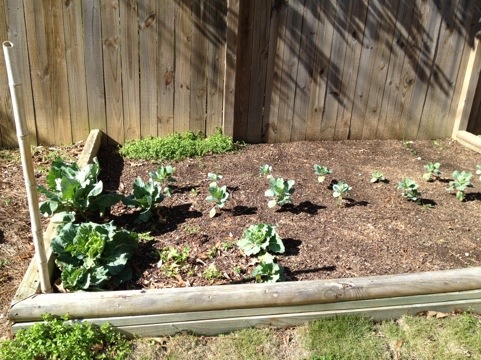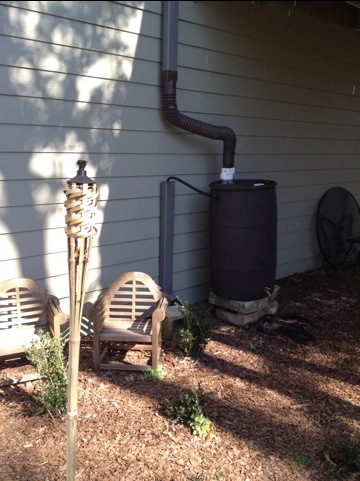9 tips about a few small things that have worked for me:
1. Home garden
We’ve eaten lots of collards and cabbage this winter from the backyard garden. Collards grow so well here, and the bugs don’t touch them! The herbs have also done great. We had a crazy surplus of basil and parsley this summer. We also had some thyme, and the cilantro does well during the cooler parts of the year.
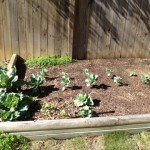
Cabbage and Collards
We didn’t have quite as much luck with our tomatoes this summer. I think we ended up with eight wee tomatoes, enough for one veggie sandwich! But it’s so fun to cook with things that come from your own backyard.
It makes sense on so many fronts. I use the water from the rain barrels to water the garden. (The hardest part is making myself walk down the deck stairs to the garden!) We grow the veggies organically, so there’s no pesticides used. There’s no energy wasted in the food being transported, and I don’t have drive anywhere to pick it up. Plus it costs pennies to buy the seeds and organic fertilizer, compared to the cost of the produce itself.
I know the idea of a garden can seem like an overwhelming amount of work, but if you do it on a small scale, it really doesn’t require much maintenance. Some things like herbs, lettuce and tomatoes can even be grown in pots on your porch!
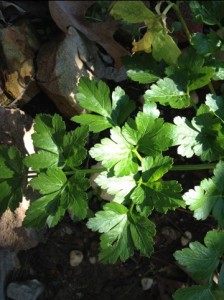
Parsley from the backyard
2. Chemical free lawn
I don’t use any chemicals to treat for weeds in my lawn. The chemicals get absorbed into our groundwater and are found in the runoff that goes to our lakes, rivers, and streams, compromising their delicate balance and biodiversity, and ultimately ending up in our drinking water.
Zoysia is a very dense, shade-tolerant sod, making it difficult for weeds to grow through it. I put zoysia sod in my backyard over the summer. It’s a little more expensive on the front end but can make for less maintenance in the long run. I’ve also found some natural weed killers that I’ll use occasionally in natural areas, but they can be pretty expensive if you’re trying to cover large areas. Vinegar and water is another suggestion that I’ve heard, but it didn’t bother my weeds a bit.
My lawn doesn’t look perfect, but it’s nice enough, and I’d rather have a less-than-perfect lawn than to unnecessarily put more chemicals into the ground.
3. Sentricon termite bait system
The soil of most homes is pretreated during construction with hundreds of gallons of chemicals to prevent termites. I opted for a system called Sentricon. Sentricon is a system of small baits placed around the house that are monitored quarterly by your pest control company. If any termites are found in the baits, then they treat for termites.
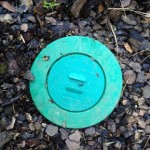
Sentricon Bait Station
I use Wayne’s Pest Control, and the only downside to this system is that is costs $75 quarterly for the monitoring and termite bond, but there is no upfront cost. And again it’s worth it to me to avoid having all those chemicals pumped into the ground.
The blown Cellulose insulation that I mentioned in a previous post can also be a deterrent for termites and other critters. Since I’ve been in my home, except for the occasional roach, I’ve had very few bugs, so maybe that’s had something to do with it!
4. Mohawk SmartStrand Carpet
Mohawk has a carpet made partially from corn fibers. It is made from 37% renewable resources, requires 30% less energy to produce, supposedly releases no VOCs (volatile organic compounds found in paints and carpets that can be toxic to humans), and emits 63% less greenhouse gas in production.
Aside from these environmentally friendly things, the quality is superior, even though the cost (when I built my house in 2007) was comparable to other medium grade carpets. It’s naturally stain resistant and never loses its texture. Mohawk installed this carpet in the rhino enclosure at the Birmingham Zoo for two weeks, and after being cleaned it looked as good as new! I’ve been in my house for 4 years now, and it still looks new, even after spilling red wine on it!
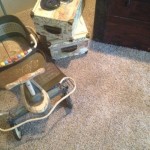
Mohawk Smartstrand Carpet
5. Low or no VOC paints.
Low VOC paints have come a long way in quality and affordability in the last few years. Lowe’s, Home Depot, Sherwin Williams, and Benjamin Moore all carry affordable versions of a LOW to no VOC paint. When we first used them about 8 years ago, there was a noticeable difference in how many coats we had to apply and in the quality of the paint. But that’s not true anymore. You can save yourself some exposure to some volatile-ly organic compounds for a comparable price!
6. I-beams
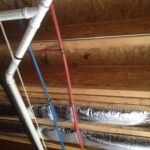
I-beams/ I-joists in my basement
A timber I-beam or I-joist uses one-sixth the wood of a conventional joist for the same strength. They are made of wood composites so can be made of younger, more sustainably sourced woods and they’re lighter and easier to cut. They’re stronger than regular lumber, keeping your floors level over time, and also allowing you to span larger distances or create more ceiling height. When I built my home, the price of lumber had gone up, and I also had large, open spaces on the main level that needed to be supported, so in my case, it cost about the same as regular lumber to use the I-beams in construction.
7. Change out yo’ light bulbs
A Virginia Tech professor, Tamim Younos, and undergraduate student Rachelle Hill carried out a research study on the water-efficiency of some of the most common energy sources and power generating methods. For one part of the study, Hill calculated how many gallons of water are required to burn one 60-watt incandescent light bulb for 12 hours a day, over the course of one year. She found that the bulb would consume between 3,000 and 6,000 gallons of water, depending on how water-efficient the power plant that supplies the electricity is.
“The numbers are even more staggering if you multiply the water consumed by the same light bulb by the approximately 111 million U.S. homes,” said Hill. “The water usage then gets as high as 655 billion gallons of water a year.” By contrast, burning a compact fluorescent bulb for the same amount of time would save about 2,000 to 4,000 gallons of water per year.
And with LEDs becoming more and more affordable, the amount of money, energy and water you can save just by changing your light bulbs is incredible. Here’s a link to a great blog, The Simple Dollar, where you can find more specifics about how much you can save. With the current cost of LEDs, over 10,000 hours of usage for 12, 60 watt bulbs, you could save about $750.
8. Reuse

me and my jar
I try to reuse and repurpose as many things as I can. Especially glass jars! People at work freak when they see me eating cereal out of a Tostitos jar, but why spend money on Tupperware, when we can just wash our salsa and spaghetti jars and reuse them! We also save ourselves from being exposed to toxic chemicals that can be found in plastic.
Chris and I also bought a glass bottle-cutter online and have cut some of our wine and beer bottles to make drinking glasses and vases. It was more work than we imagined, so the whole mass production of artsy, upcycled drinking glasses didn’t quite work out. But it’s a fun way to never buy drinking glasses again!
9. No bags at the grocery store
People in the check-out line get bewildered when I say that I don’t want any bags for my groceries or other purchases. Within the last couple of weeks I’ve heard, “Well, they might think you’re stealing that.” or “I’ll just feel weird if I don’t put this in a bag.” Those were really cute responses, but it just amazes me sometimes how attached we are to our way of doing things. If I remember, I try to carry a reusable shopping bag, but if not I just put stuff directly in my car from the buggy and then grab the bags when I get home. I’m sure this could be more of a challenge if you live on the third floor of an apartment building!
Just a few ideas that have been easy for me to incorporate!
Next week Rebecca, David, and I are meeting all together for the first time to finalize the schematic design of the home. David’s going to help us understand the Passive House concept in more detail, so we can keep that in mind as we work on window placement and other final design elements. I’m really looking forward to it! I’ll post the latest version of the floor plan before our meeting and then keep you posted about our progress.
